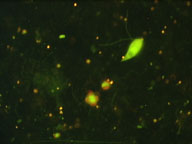
|
Marine organisms are often classified
by how they move (e.g., plankton cannot swim against a current),
where they get their energy (e.g., "phyto" usually applies
to photosynthetic organisms), and their size (see chart below).
This overview is intended help "sort out" the confusion!
|
 |
||
|
These "generic" names classify plankton
by size
|
||
|
This shows typical size ranges for some common
marine groups
|
||
| This shows the range of sizes for these classifications | ||
|
|
||
 |
Megaplankton are the largest plankton. They range in size from 20 centimeters (8 inches; about the width of a sheet of paper) to 200 centimeters (6.5 feet; around Michael Jordan's height). Floating animals in this size range are called "megazooplankton." |
 |
|
|
||
 |
Macroplankton
are relatively large plankton. They range in size from 2 centimeters
(0.8 inches; about the width of a U.S. nickel) to 20 centimeters
(8 inches). Floating animals in this size range are called "macrozooplankton."
Floating plants in this size range are called "macrophytoplankton."
|
 |
|
|
||
 |
Mesoplankton are from 200 micrometers
(about 4 times the width of an average human hair) to 2 centimeters
(0.8 inches). Floating animals in this
size range are called "mesozooplankton." Floating
plants in this size range are called "mesophytoplankton."
|
 |
|
|
||
 |
Microplankton are between 20 micrometers and 200 micrometers in size: i.e., from about half a hair width to about four hairs wide. Floating animals in this size range are called "microzooplankton." Floating plants in the this range are called "microphytoplankton." |
 |
|
|
||
 |
Nanoplankton are between 2 and 20 micrometers
(i.e., much smaller than a hair's width). The smallest phytoplankton
are in this size range (see chart at top). Special
techniques are often used to identify these tiny organisms;
e.g., staining the cells' cytoplasm
and viewing them under fluorescent light.
|
 |
|
|
||
 |
Picoplankton
are between 0.2 and 2 micrometers and are commonly called "marine
bacteria." Members of the picoplankton include Prochlorococcus
and Synechococcus, species responsible for much of the photosynthesis
in the world’s oceans. Like nanoplankton, special
techniques are often used to identify bacteria; e.g., staining
the cells' DNA and
viewing them under ultraviolet light (>>).
|
 |
|
|
||
|
Femtoplankton
are less than 0.2 micrometers and are commonly called "marine
viruses." Viruses are neither cells nor considered to be "alive":
they consist of a protein coat around a clump of genetic material.
|